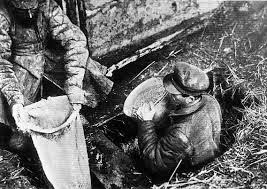 |
| Chicago American - Monday, February 25th, 1934 |
Since 2006, the Holodomor has been recognized by many countries as genocide of the Ukrainian people. History notes that the destruction of the Ukrainian peasantry was premeditated on the part of Joseph Stalin. The term Holomodor emphasizes the man-made causes of the famine, like the Soviet confiscation of private property, farmland, livestock, wheat crops, and all the implements of farm and industrial production.
A campaign of terror was unleashed on ethnic Ukrainians, primarily in the southeastern "breadbasket" region of the country. Those who resisted Soviet authorities were shot or deported to Siberia. Families who attempted to hide their grain stocks were killed. Even so, some families chose to burn their homes to the ground and kill their livestock rather than hand them over to their Soviet overlords.
With the exception of grain reserves used to feed livestock and not people, the vast bulk of Ukrainian grain was exported to neighboring countries to generate revenue for fueling Stalin's Five Year Plan. The Soviet Union was able to purchase Western commodities, among them military weapons and hardware. In return, those countries turned a blind eye to the Soviet Union's internal problems.
In addition to Ukrainian farm peasants, more than 5,000 Ukrainian intellectuals were arrested and charged with plotting an armed rebellion. Those who were not summarily shot were deported to Siberian labor camps, never to be heard from again. It is believed that Stalin feared a general revolt in support of Ukrainian nationalism. The Soviet goal was to have Ukrainians abandon all nationalistic fervor. This preemptive move left the rest of the population without leadership or direction.
For more detailed information on Holodomor, visit the United Human Rights Council's site at:
http://www.unitedhumanrights.org/genocide/ukraine_famine.htm
To view the many monuments dedicated to the victims of Holodomor, tap on this link: http://en.wikipedia.org/wiki/Holodomor#mediaviewer/File:Holodomormemorialbloomingdale.jpg


แหล่งรวมความสนุกและชดเชยการขาดแคลนผู้เล่นที่สนใจสร้างรายได้จากค่ายเกมสล็อตเมก้า เปิดเป็นอีกช่องทางหนึ่งในการหารายได้ออนไลน์ผ่านเว็บไซต์ รีวิวเกมสล็อตออนไลน์ mega game ของคุณ มีเกมสล็อตแมชชีนที่สามารถสร้างรายได้มากกว่า 150 เกมจากเครื่องสล็อต เล่นได้ไม่จำกัด การันตีการแจกสูงถึง 95% ของเงินรางวัลรวมเป็นอีกแหล่งรายได้สมบูรณ์ตลอด 24 ชม.
ReplyDeleteGood morning!! I am also blogging with you.
ReplyDeletemale masturbation cup
electric masturbation cup